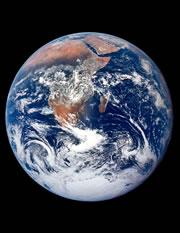 Wobbles in the orbit could wipe out life.Getty
Wobbles in the orbit could wipe out life.GettyCan a tiny change to the Earth's orbit wipe out life? New evidence suggests that perhaps it can — in Spanish rodents, at least.
The Earth is well known to fluctuate in a number of defined ways: its axis wobbles about; its tilt with respect to the Sun changes; and the degree to which its orbit isn't circular varies too. These astronomical forces, known collectively as Milankovitch oscillations, can affect the climate on Earth by altering the amount of sunlight received by different regions of the globe.
Whereas Milankovich oscillations normally operate on a relatively short timescale of 20,000-400,000 years, the magnitude of these cycles varies with lower frequency, over millions of years. It is unclear whether these variations have affected life on Earth.
Previous work has suggested that life has been remarkably resilient to climate change. "This has been a real controversial area in our little world of palaeontology," says Anthony Barnosky of the University of California, Berkeley.
“This has been a real controversial area in our little world of paleontology.”
Anthony Barnosky, professor of paleontology at the University of California at Berkeley.
Some have wondered whether previous studies failed to spot die-offs associated with Milankovitch-linked oscillations because they pooled data from different parts of the globe. "People look at it from a whole bunch of different spatial and temporal scales," says Barnosky. "They may lump together, say, Oregon and southern Utah, where climate changes might be different."
Dental records
To get around this problem, Jan van Dam of Utrecht University in the Netherlands and his colleagues examined an extensive collection of 80,000 rodent teeth from central Spain. The fossils, collected over 40 years of sifting through soil along riverbanks and construction sites, range from 24.5 to 2.5 million years old.
The team mapped out which species lived in which time periods. With this information, they found evidence for two different cycles of die-offs, each taking up to 30% of the species alive at the time. Every 2.4-2.5 million years there was a small extinction, and on top of this, every 1 million years came a die-off too. These frequencies match up to recently discovered variations in Milankovitch cycles.
One die-off occurred around 14 million years ago, for example. This coincides with a time when Earth's orbit was much more circular than normal, reducing the contrast between seasons. This would have brought cooler summers to higher latitudes, reducing ice melt and leading to a cooler climate — apparently with negative effects for the rodents in Spain.
Local answers
Donald Prothero, of Occidental College Los Angeles, says that the fossil record used by van Dam is extraordinary, but questions how applicable his results will be to species other than rodents. "It's okay as far as it goes," says Prothero. "But I wouldn't necessarily extend the applications too far."
ADVERTISEMENT
van Dam says that if highly detailed fossil records were available for larger mammalian species, the same patterns would probably emerge. "I would expect that if people are able to look in detail at these groups," says van Dam, "they will find the same pattern."
But, adds Barnosky, the effects may still not be global: an Earth wobble that killed in Spain may have spared life in Utah. "One of the problems is that people like tidy answers," says Prothero. "But really there are a lot of loose ends that haven't been tied up yet."
Visit our orientationlinkedtoe.html">newsblog to read and post comments about this story.
-
References
- van Dam J. A., et al. Nature, 443 . 687 - 691 (2006). | Article |
